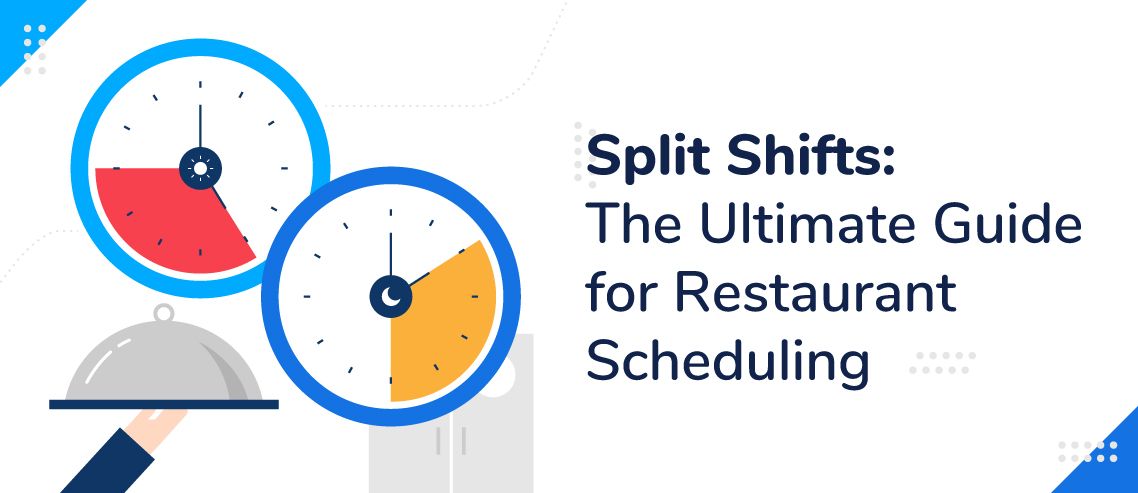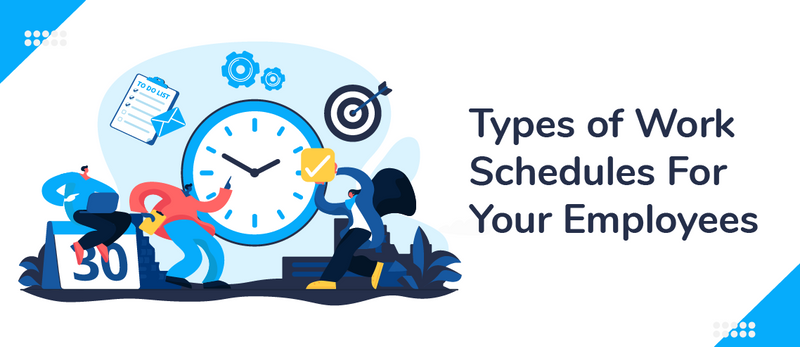Swing Shifts — How to Use and Implement Them Effectively

Every business is different. While a 9-to-5 workday may suit some companies, there are a great many that need to operate at completely different times.
For these businesses, having swing shifts are an important part of daily operations. While these shifts are commonplace, many businesses still struggle to coordinate them effectively.
Here’s your guide to swing shifts with definitions, industries, examples, and important tips on how to make them work for your business.
What Is A Swing Shift?
Swing shift hours don’t follow a conventional 9-to-5 workday. Instead, employees work at different intervals throughout the day and night.
When working swing shifts, an employee’s schedule might change regularly, meaning they work different hours from day to day. For example, a waiter may work the morning shift on a Monday from 6 AM to 2 PM, but work the afternoon shift on Tuesday from noon until 8 PM.
Swing shift patterns are most common in businesses where they need to be open beyond the standard 9-to-5 hours. As consumers, we most commonly see this in the hospitality and retail industries (they’re open when you’re not at work), but swing shifts take place in many business types.
By utilizing swing shifts, factories can run 24 hours a day, maximizing their output, truck drivers can drive through the night to avoid traffic, and emergency services can be on hand whenever we need them.
How Do Swing Shifts Work?
We often focus on swing shifts from the point of view of the employees — what is it like to work swing shifts, etc. However, swing shifts also have implications for managers as well, and it’s how management overcomes these challenges that will dictate the success of swing shift patterns.
Swing shifts rely on good scheduling.
You don’t have everyone turning up at 9 AM and leaving at 5 PM every day. Instead, each day is like a puzzle, where you need to make sure you have the right pieces in the right place at the right time.
Businesses need to make sure they have the right people working together at the right time while communicating with employees effectively.
When done well, swing shifts can be a positive option for workers. The hours allow people flexibility that a 9-to-5 job doesn’t offer, but employees can only take advantage of these benefits when scheduling works like clockwork.
It’s not always easy to coordinate a large workforce (or even a small one) to make sure you have all the skills you need at any given time. You have to be able to organize your human capital in the way that works best for you though. At the same time, your employees need to be able to plan their lives around their shifts.
How successful you are at this will depend on your scheduling process.
Pros and Cons of Swing Shift Hours
Swing shift hours are a necessity for many businesses. They don’t have the luxury of telling everyone to come in at 9 AM and leave at 5 PM— it’s more complicated than that.
Just because managing swing shifts can be a little more complicated doesn’t mean you can’t be successful with it though.
Let’s look at the pros and cons of swing shifts from both the perspective of employees and management and see the key areas you need to focus on to make your shift patterns work.
For Employees
For employees, swing shifts largely depend on convenience. When done well, they can offer people a balanced schedule, but when things are left to the last minute and schedules constantly change, they can be a source of huge frustration.
Pros
- Most peoples’ lives don’t neatly fit into a 9-to-5 schedule
- Swing shifts allow you to be more flexible
- They offer variety — you get to do slightly different work with different people
- Can offer better pay with additional perks
Cons
- Less certainty
- Schedules can change at short notice
- Working when everyone else is off
- Can be long, tiring shifts
- Hard to find someone to cover your shift
For Management
Swing shifts also offer a lot of flexibility for management. They allow businesses to make sure they have the right mix of skills working at any given time, rather than having all of their employees working at the same time.
Pros
- Your business can stay open longer to reflect the needs of your clients
- Combine different skill sets as needed
Cons
- Impact on employee’s health
- Less certainty — more confusion on shift timing
- Difficult manage balance schedule of each employee
- Hard to manage shift cover request
Common Swing Shift Hours
Swing shift hours vary from business to business, but there are some common patterns you’re likely to see. The most important thing about swing shifts is they reflect the needs of your business.
It’s common to use swing shifts in industries where work needs to be done around the clock. When your business is open 24-hours a day, it’s particularly important to make sure you’re managing your employee’s shifts so they don’t suffer from burnout.
You regularly see this in the following industries:
- Hospitality
- Retail
- Health Care
- Transportation
- Customer Service
- Public Safety
While these might be the industries that most commonly utilize these patterns, swing shifts can be implemented in any business. When done right, this can unlock new levels of output while enhancing the employee experience.
To give you an idea as to how a swing shift schedule might work for your business, here are some common swing shift patterns and hours.
Swing shift patterns:
- Eight-hour shifts: either fixed (eg 12-8 Monday through Friday) or varied (eg morning shift Monday, Wednesday, Friday, afternoon shift on Tuesdays and Thursdays)
- Ten-hour shifts: four days on, three days off.
- Twelve-hour shifts: One day on, multiple days off.
Swing shift hours:
- Afternoon shift: employees begin work in the afternoon, working from around 3 PM to midnight.
- First shift: First shift tends to be similar to regular business hours, employees will work from around 9 AM to 5 PM.
- Second shift: Second shift is similar to the afternoon shift, typically starting work around 3 or 4 PM.
- Third shift: Third shift normally takes over after the second shift ends. If the second shift ends at midnight, then that’s when the third shift would start.
- Fixed shift: This is where an employee works a fixed pattern of hours. They may work the second shift 5 days a week.
- Split shift: In a split shift, employees work two shortened shifts in a day. For example, they may work from 8 am to noon, and then from 6 PM to 10 PM.
Seems like a lot of scheduling work, doesn’t it? It doesn’t have to be! With ZoomShift, you can easily set your swing shift schedules all on a single platform with no- hassle for your employees.
Scheduling Swing Shifts with ZoomShift
When it comes to swing shifts, it’s hard to underestimate the importance of good scheduling.
As most managers know though, scheduling employees is extremely tedious and can be time-intensive. Part of the appeal of swing shifts is efficiency, but it’s fairly counterproductive if you’re spending all your time planning next week’s shifts.
ZoomShift is ideal for swing shifts because of its powerful templates. You can create your weekly/monthly schedule template and use it time and again.
Generally, the actual shifts themselves don’t change a great deal from week to week. It’s more about putting the right employee in the right shift at the right time. With Zoomshift, you can save shifts as templates, so you can easily duplicate them in the future.
Once your shift template is set up, then the magic of ZoomShift allows you to effortlessly see which employees you have available for each shift. Add employees to open shifts at a click of a button, and instantly share your schedule with all relevant employees.
If you find your schedules are similar from week to week, then save the entire schedule, so you can copy and repeat for the weeks and months to come.
With ZoomShift, everything comes together in one place. The scheduling, communication, and payroll are all linked, which helps save time and eliminate errors.
Intelligent templates and clear access to information help you make better schedules, allowing you to get the most out of your swing shift patterns.
Benefits of using ZoomShift to schedule your employees:
For managers:
- Trouble-free operation — Right People, Right Place, Right Time
- Enables open shifts for employees working in flexible hours
- Add shift notes for your employees
- Simple time tracking and Payroll
- Manage workload — warn the risk of working overtime
- Employees will show up on time
- Track and manage paid time off
For employees:
- Get instant email and mobile app notifications for new and latest changes in schedules
- Log in using a mobile app with an inbuilt GPS tracking system
- Create shift cover requests within the app
- Track of available PTO
To streamline your swing shift scheduling get started with ZoomShift. It will eliminate all the manual errors and make your employee consistently show up to work on time.
How you can schedule employees using ZoomShift?
How to Implement a Swing Shift in Your Business
Here are eight considerations to keep in mind when implementing a swing shift in your business:
1. Assess Business Needs
Evaluate whether a swing shift makes sense for your business. Look at your operations closely—are there times when demand spikes or when extended service hours could benefit your bottom line?
Identify which tasks or departments would truly thrive with this new schedule. If the demand is there, it’s worth moving forward.
2. Consult With Employees
Talk to your employees about the potential shift change and listen to their feedback. They might have insights or concerns you hadn’t considered.
Address any concerns that pop up and ensure this new schedule doesn’t mess up their work-life balance or hurt morale.
3. Design the Shift Schedule
Decide on the specific hours based on what makes the most sense for your operations. Also, consider whether shifts will be rotational or if they’ll have fixed assignments where employees stay on one shift permanently.
Next, use an employee scheduling tool like ZoomShift to make a schedule for your employees.
4. Ensure Legal Compliance
Ensure you’re in compliance with local labor laws regarding shift work, overtime, and employee rights.
If you need to, update employment contracts to reflect the new shift structure. Staying on the right side of the law is key to avoiding headaches down the road.
5. Communicate Clearly
Announce the changes to all employees well in advance so they have time to adjust. Provide detailed explanations on how the swing shift will operate, including start and end times, break periods, and any rotation policies.
6. Provide Training and Support
Provide training and support tailored to the needs of the swing shift. This might include specific training for night-time operations or particular customer service protocols.
Also, think about any support systems you might need to put in place, like transportation assistance for late shifts or extra security measures.
7. Monitor and Adapt
Hold regular check-ins to gather feedback and assess the effectiveness of the new schedule.
Be ready to make adjustments based on what you hear from your team and what you observe.
8. Offer Incentives and Compensation
Make sure your swing shift workers are fairly compensated. This might mean offering shift differentials or bonuses to make it worth their while.
Consider providing other incentives too, like flexible scheduling options, additional time off, or other perks to keep your team motivated and happy.
FAQs
What Is the Difference Between a Swing Shift and a Split Shift?
In a swing shift, an employee might work from 9 AM to 5 PM one week and then from 12 PM to 5 PM the following week.
In contrast, an employee on a split shift might work from 9 AM to 2 PM, take a break, and then return to work from 5 PM to 7 PM on the same day.
Which Industries Commonly Use Swing Shifts?
Swing shifts are prevalent in industries that require around-the-clock operations, such as hospitality, retail, healthcare, transportation, customer service, and public safety.
How Does ZoomShift Help With Swing Shift Scheduling?
ZoomShift offers an all-in-one platform for scheduling, time tracking, and payroll. It provides templates to save and duplicate shifts easily, makes it simple to add employees to open shifts, and ensures clear communication through mobile app notifications.
How Can I Get Started With ZoomShift for Swing Shift Scheduling?
You can get started with ZoomShift by visiting our website. We offer free trials, demos, and a range of resources to help you understand how our platform can be tailored to your business needs.
Final Thoughts
Swing shifts are a vital scheduling tool for many businesses. They allow companies to meet demand, maximize output, and get the most out of their workforce.
Coordinating lots of people isn’t straightforward though, and one thing that holds many businesses back is scheduling. There’s no need to struggle with multiple spreadsheets, email threads, and messaging groups — ZoomShift brings everything together in one place and makes swing shifts work for everyone.
JD enjoys teaching people how to use ZoomShift to save time spent on scheduling. He’s curious, likes learning new things everyday and playing the guitar (although it’s a work in progress).



